Changing island society following the opening of the island bridge and Sustainable Development of Island Society of Korea
Abstract
When an island, an isolated space, is connected to land or other islands, it brings many changes. In other words, the change in traffic conditions is an important variable altering and determining the characteristics of the island. The objectives of this study were to examine the changes in the island region due to the construction of the land to island bridge and propose policy measures for the sustainable development of the changing island society. It is undeniable that the opening of the land to island bridge has a profound impact on the lives of islanders, the economic conditions of the island, and the environment. They change the island as fast as the dramatic change in transportation (from ships to cars). Although it is impossible to go against this trend, it is necessary to ponder the conservation of each island’s unique value, the ontology of the island, before constructing the land to island bridge. If so, what should be prepared to create a sustainable island society after opening the land to island bridge? First, sufficient discussion should be made on the construction of the land to island bridge. Second, when the land to island bridge will be constructed, it is needed to increase the receptive capacity of the islanders during the construction period. Third, a long-term development plan specifically for the island should be established before the land to island bridge is completed. Fourth, it is necessary to develop content using local resources instead of letting outsiders consume island space. Fifth, the changing island society must prepare a third place for maintaining the community
Keywords
Changing Island Society, Land to Island Bridge, Islander, Social Capital, Environment, Sustainable development
1. Introduction
1.1. Research Question
An island is a relatively small, isolated land that is surrounded by the sea. From the old days, Korean islanders have lived while building relationships with the people living in neighboring islands and land away from their isolated spaces. They crossed water to other islands and land by ferry. Islanders living around the west and south coast of Korea also crossed the water by building steppingstones over the mudflat exposed at low ties, thanks to the wide tidal flats and large tidal differences in the regions. South Korea has been connecting more islands to land by constructing structures such as marine bridges since the opening of Ganghwa Bridge in Incheon in 1969.
When an island, an isolated space, is connected to land or other islands, it brings many changes. In other words, the change in traffic conditions is an important variable altering and determining the characteristics of the island. The land to island bridge refers to bridges connecting islands with other islands or land and it functions like a road network in the inland region (Um et al., 1997; Patarasuk & Binford, 2012). Therefore, they bring the effects of securing marine transportation facilities regardless of weather conditions, improving living conditions, enhancing homogeneity between regions, and expanding the scale of islands (Um et al., 1997; Patarasuk & Binford, 2012). The opening of these bridges increases the demand for goods and services using various resources, including the aquatic resources of the island, by encouraging tourists or neighboring islanders to visit the island, in addition to changes in the life of the islanders (Chen et al., 2017; Sun et al., 2019). However, they have brought negative changes as well as positive changes. After the construction of the bridge, the population decline in the island area is sometimes further aggravated due to population outflow and social problems (e.g., road congestion, garbage, and crime) may occur.
The South Korean government has implemented the land to the island bridge project in earnest since 1969, and the scale and number of these bridges have been rapidly increasing since the 2000s. As of the end of 2020, 19.1% of islands are connected to the land. Although it is a small number compared to the number of islands not connected to the onshore, this affects 88.4% of the total island population. Therefore, the impact of this policy on the islands is not small.
Based on this background, this study started with the following questions. First, is the construction of the land to island bridge a policy that guarantees the sustainability of the island society? Second, what are the impacts of the construction of the land to island bridge on the lives of islanders? Third, what kind of policy measures are needed to make the changing island society a space for sustainable living?
The objectives of this study were to examine the changes in the island region due to the construction of the land to island bridge and propose policy measures for the sustainable development of the changing island society.
The main scope of the study was island society and the construction of the land to island bridge. The case area was islands connected by bridges in Shinan-gun. Sinan-gun is the only local government made up of islands in South Korea. Since it is composed of islands, it has been promoting development projects to improve accessibility between islands and between islands and inland for regional development. Among the 22 lands to island bridge projects of Shinan-gun, 13 projects have been completed as of April 2021. The media has reported that the completion of these land to island bridges has brought many changes in the lives of the residents of these islands.
First, this study derived analysis indicators by reviewing previous studies published in South Korea and other countries related to the completion of the land to island bridge. Second, this study evaluated the changes in island society due to the completion of the land to island bridge as reported in newspaper articles. Third, this study analyzed the changes in the islands connected to the land using various statistical data. Fourth, this study conducted an interview for residents living in the islands recently connected to the land by bridges from June 8 to October 3, 2021.
2. Theoretical Background and Research Trend
2.1 Land to Island Bridge and Islands
Islands have a relatively inferior industrial foundation and settlement environment than the land. It is because transportation between islands and the land is not easy, islands are narrow, and they do not have enough resources due to the constraints of the physical environment, the sea. Therefore, the role of ships connecting to the land and the island is very important in the island region. In other words, the interregional connectivity is greatly affected by the special traffic condition that islands can only be accessed by ships (Park, 2021). Islands suffer from inconvenience and cost problems because the ship is the only available means of transportation, it is greatly affected by the weather, the number of ship operation is low due to high transportation cost, as a result, traffic time is excessive, traffic cost is too high, and the transportation system is composed of multiple steps (Parn et al., 2016; Tzanopoulos & Vogiatzakis, 2011).
Consequently, the most favorite regional development project of South Korean islanders is the construction of the land to island bridge, which can resolve the isolation and narrowness issues of islands (Shim, 2013; Shin & Park, 2019). This change in traffic conditions is an important variable in changing the characteristics of the island region. Since undersea tunnels as well as the land to island bridges will be constructed for revitalizing the construction industry and satisfying the demand of the residents, it is needed to pay attention to changes in island society and its responses.
2.2 Research Trends and Analysis Perspectives
When the isolation issue is completely resolved in the island area, which is surrounded by the sea, the society undergoes many changes (Baldacchino et al., 2007). However, there are not enough studies on the changes in the island society due to the construction of the land to island bridge.
The representative study on the relationship between the island and the land to island bridge in South Korea is the study examining the changes in the living area of Anmyeondo Island residents due to the completion of the land to island bridge (Yi, 2008). In the past, the Anmyeon-do area could be divided into Taean living zone, Seosan living zone, and Gwangchoen living zone. However, as Anmyeon Bridge was constructed in 1970, Gwangchoen living zone, which relied on ships, disappeared, living activities were concentrated in Taean and Seosan living zones using road transportation. The results of this study revealed that the opening of the land to island bridge was a critical variable that could cause profound changes in the nature of the island and the lives of the islanders. The main study topic after this study is the effects of the land to island bridge on existing maritime traffic: some representative studies are the compensation for economic damage to coastal passenger ships due to the opening of the land to island bridge (Ahn et al., 2008; Lee et al., 2009; Kim, 2012), changes in unit agricultural cooperatives due to increasing in the land to island bridge in island areas (Cho and Park, 2019), and measures to revitalize the coastal transportation business according to the increase in the land to island bridge in island areas (Cho, 2018). Recent studies have approached the changes within the island society in terms of tourism and real estate: representative studies are changes in the tourism space on the island due to the opening of the land to island bridge (Jeong et al., 2019) and changes in the island real estate market following the opening of the land to island bridge (Park, 2021).
Japan consists of islands, and studies have been relatively active since the 1980s. Representative studies are social transformation due to the land to island bridge (Maehata, 2005, 2011), post-effects of the land to island bridge (Inuzuka et al., 2006; Maehata, 2012), changes in residents' consciousness following the construction of the bridge connecting islands (Massaki, 2011, 2012.), analysis of changes in the satisfaction of the socially underprivileged following the construction of the land to island bridge from the economic perspective (Kuronuma, 2016), examining the straw effect according to the construction of the land to island bridge based on spatial economics (Ihara et al., 2015.), and analyzing the living environment using economic theories including psychological and external factors by focusing on the changes in the utility of the subject according to the integration of islands (construction of the bridge connecting islands) (Kuronuma, 2018). These studies have focused on social transformation, changes in residents' consciousness, economic post-evaluation, and verification of economic theories after the construction of the land to island bridge. There are not enough studies on the changes and sustainability of the island society itself.
In Canada, studies on the effect of island bridges were mainly conducted. On Prince Edward Island (PEI) in Canada, the number of tourists and the amount of total tourism revenue rapidly increased at the beginning of the bridge connection (Baldacchino et al., 2007). However, bridge construction increased the number of car users and led to greater access to PEI, which decreased the number of tourists staying on the island. Moreover, due to the upward movement in property prices, a number of residents left the island (Baldacchino & Spears, 2007). In addition, the bridge construction had negative impacts on the island’s environment (Evans & Eng, 2003), which was also found in the Skye Island case in Scotland. Consequently, islands might be influenced by a considerable number of external factors because of the ‘bridge effect,’ which is observed after bridges are built to connect islands to the mainland (Jeong et al., 2019).
This study paid attention to a viewpoint that had not been evaluated in previous studies. First, this study examined the population dynamics and changes in the perceptions of the residents by using statistical data and interviews. The population is accepted as an absolute means for evaluating the strength of a community and is a critical factor representing competitiveness. The land to island bridge is promoted as a project to improve accessibility to the land and develop the region. Therefore, it was confirmed through changes in population and the perception of the residents.
Second, this study examined the changes in social capital following the opening of the land to island bridge. Putnam (2001) argued that social capital could be divided into bridging social capital and bonding social capital. Bonding social capital is formed through relationships between people with similar social backgrounds, such as families and villagers. Therefore, a strong bond is made when bonding social capital increases. A strong bond has the characteristic that it increases personal intimacy while decreasing diversity. Since community spirit is reinforced through an increase in personal intimacy, mutual aid relationships become active when the community faces a danger. However, it also has shortfalls. For example, it may show exclusive behaviors toward others due to excessive intimacy or opportunistic behaviors in close personal relationships. In contrast, bridging social capital is formed through relationships with people who have different social backgrounds. When bridging social capital increases, a weak bond is formed. Since bridging social capital is formed through various human relations with relatively low intimacy, a wider human relation is created. Therefore, bridging social capital is helpful for acquiring new information or resources due to its nature. As a result, it facilitates regional economic growth owing to wide information and resources. In terms of social relations, it also suppresses opportunistic behaviors to maintain reputation within the group. This study evaluated social capital in relation to the opening of the land to island bridge in Sinan-gun.
Third, this study examined the changes in the environment of the island due to the opening of the land to the island bridge. The characteristics of islands are different from those of land because they are surrounded by the sea. Therefore, they are more sensitive to changes. Here, changes in the environment refer to the combinations of nature, society, culture, and all elements created by them at a given time in a given space, more than changes in the natural environment. In summary, this study derived the sustainable counterstrategies of the island society due to the opening of the land to island bridge after examining the changes in the life of islanders in terms of changes in population, perception, social capital, and environment after the opening.
3. Status and Cases of the Land to Island Bridge in South Korea
3.1 Construction of Land to Island Bridge
The first land to island bridge was Yeongdodaegyo Bridge, also called Yeongdo Bridge, located in Busan. The bridge was built in 1934 during the Japanese colonial period. The number of the land to island bridges has been steadily increasing, such as Ganghwa Bridge in 1969 and Anmyeon Bridge in 1970. In fact, South Korea has carried out the land to island bridge construction project as a part of the National Transportation System Establishment Project, and the scale of this project has been increasing since the 2000s (Park, 2021). Figure 1 shows the trend of the completion of the land to island bridge by era.
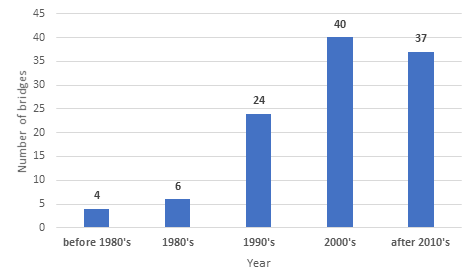
As of the end of 2020, 55 bridges connecting the land and the island were constructed in South Korea, while South Korea had 465 inhabited islands (Park, 2021). When including bridges connecting an island and an island, 111 bridges connect an island to other islands or the inland to provide a passage for people and goods to move freely. Jeollanam-do Province has 65% of South Korea’s islands, 59 out of 111 lands to island bridges (31 bridges connecting islands and inland and 28 bridge connecting islands) have been built in this province. Construction is still ongoing.
After an island is connected to the inland, the living conditions of the residents and regional development policies of the island become much different from those of islands that are not connected to the land. As of the end of 2020, there are 89 islands (19.1% of all inhabited islands) that can be accessed by car or on foot from the land. In terms of geographical distribution, Busan has 3 (2.4%), Incheon has 10 (11.2%), Gyeonggi-do Province has 1 (1.1%), Jeollabuk-do Province has 6 (6.7%), Gyeongsangnam-do Province has 14 (15.7%), and Jeollanam-do Province has 49 (55.1%). The total area of islands connected to the land is 2,681.9 km2, accounting for 70.9% of the total inhabited island area. In addition, the total population of these islands connected to the land is 745,340, which is 88.4% of the total island population. The mean population per island connected to the land is 8,375, which is relatively higher than the island not connected to the land (Shin, 2021; Park, 2021). Moreover, the mean area per island connected to the land is 30.1km2, which is larger than that of the islands not connected to the land (Shin, 2021; Park, 2021). The results revealed that the land to island bridge was built mainly for larger islands and most islanders lived in islands connected to the land. As a result, the land to island bridge project has a large impact on the lives of islanders.
| Busan | Incheon | Gyeonggi | Chung nam | Jeon buk | Jeon nam | Gyeongnam | Total | |
|---|---|---|---|---|---|---|---|---|
| Number of islands (N, %) | 3 (3.4) | 10 (11.2) | 1 (1.1) | 6 (6.7) | 6 (6.7) | 49 (55.1) | 14 (15.7) | 89 (100.0) |
| island area (km2, %) | 38.76 (1.4) | 546.64 (20.4) | 1.42 (0.1) | 128.86 (4.8) | 12.03 (0.4) | 1,146.73 (42.8%) | 807.48 (30.1) | 2,681.93 (100.0) |
| Population (N, %) | 120,282 (16.1) | 163,104 (21.9) | 576 (0.1) | 12,944 (1.7) | 1,638 (0.2) | 116,939 (15.7%) | 329,857 (44.3) | 745,340 (100.0) |
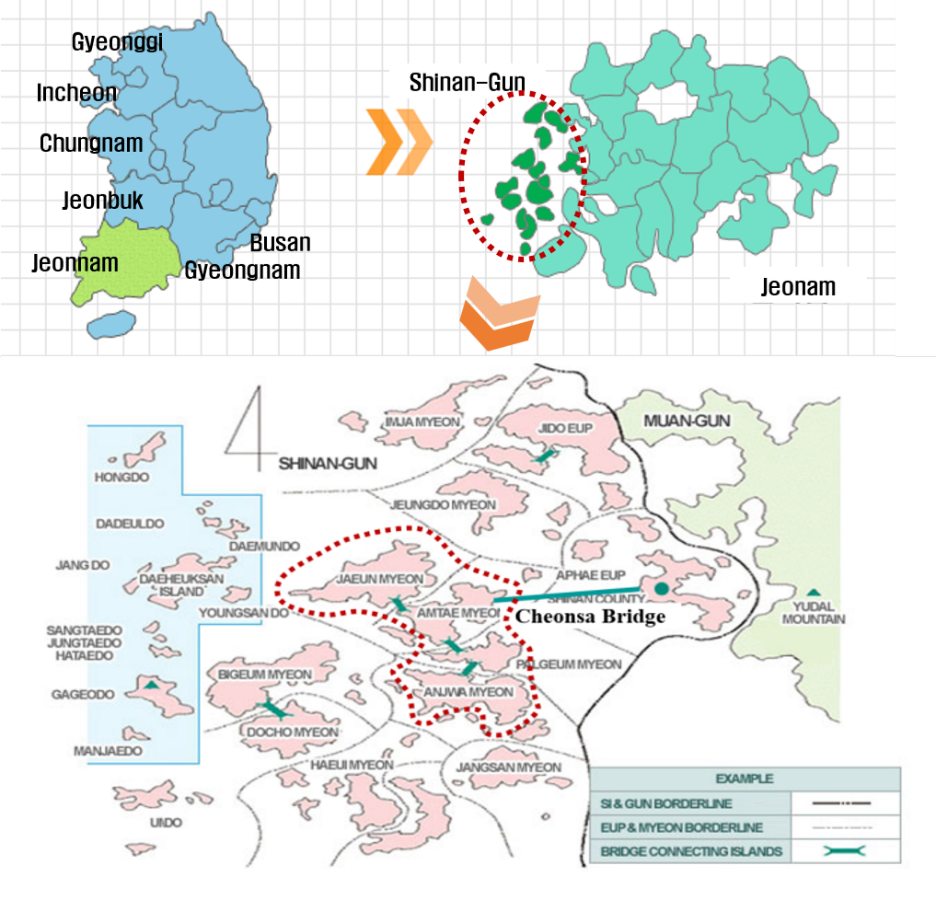
3.2 Land to Island Bridge Project in the Study Area
The regional development of Shinan-gun has been limited due to its geographical characteristics as islands. Since the means of transportation to and from the land was a ship, it has had poor accessibility for a long time due to the influence of weather conditions and other factors.
The marine bridge construction started in 1986. Currently, there were 22 projects with a total length of 66.404km and a total project cost of KRW 3,840.4 billion. Among them, the construction of 13 sections (KRW 1,503.7 billion) was completed as of April 2021 (Table 2). The greatest achievement among the land to island bridge projects is the Cheonsa Bridge, which connects four islands (Anjwa-do, Palgeum-do, Amtae-do, and Jaeun-do).
| Bridge name | Location | Bridge Pictures | Length(㎞) | Construction cost (KRW billion) | Start of construction | Completion | Management office* | Note** |
|---|---|---|---|---|---|---|---|---|
| Shinan 1st Bridge | Anjwado-Palgeumdo | 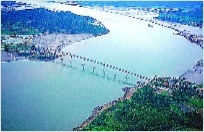 |
0.540 | 153 | 1986.11 | 1989.12 | JN | BCI |
| Eunam Bridge | Jaeundo-Amtaedo | 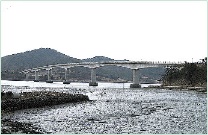 |
0.675 | 202 | 1990.12 | 1996.05 | JN | BCI |
| Seonammun Bridge | Bigeum-Docho | 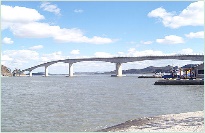 |
0.812 | 244 | 1989.12 | 1996.09 | ICMA | BCI |
| Jido Bridge | Jido-Saogdo |  |
0.660 | 474 | 1997.12 | 2005.02 | JN | BCI |
| Jungang Bridge | Palgeumdo-Amtaedo | 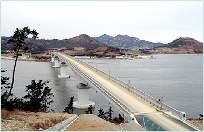 |
0.500 | 527 | 1997.11 | 2005.06 | JN | BCI |
| Abhae Bridge | Mokposi- Aphae |  |
1.840 | 2,124 | 2000.06 | 2008.06 | ICMA | LIB |
| Jeungdo Bridge | Saogdo-Jeungdo | 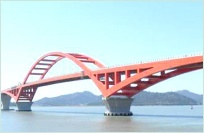 |
0.900 | 797 | 2005.08 | 2010.07 | JN | BCI |
| Kim Daejung Bridge | Abhaedo-Yunnanmyeon (Muahn-gun) | 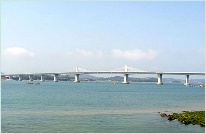 |
6.400 | 1,391 | 2003.06 | 2013.12 | ICMA | LIB |
| Samdo Bridge | Hauido-Sinuido | 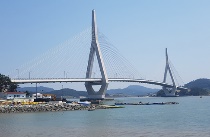 |
1.389 | 706 | 2010.05 | 2017.06 | ICMA | BCI |
| Jara Bridge | Anjwado-Zarado | 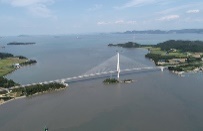 |
2.003 | 485 | 2011.12 | 2018.04 | JN | BCI |
| Cheonsa Bridge | Abhaedo-Amtaedo | 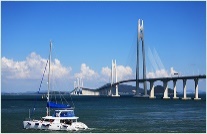 |
10.800 | 5,814 | 2010.09 | 2019.04 | ICMA | BCI |
| Imja Bridge | Jido-Imjado | 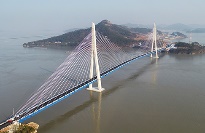 |
4.990 | 1,766 | 2013.08 | 2021.03 | ICMA | BCI |
| Chupo Bridge | Chupodo-Amtaedo | 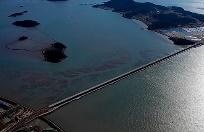 |
1.820 | 354 | 2016.04 | 2021.03 | ICMA | BCI |
* ICMA (Iksan Construction and Management Administration), JN (JeollaNamdo).
** BCI (Bridge connecting Islands), LIB (Land to Island bridge).
4. Analyzing the Changes in Islanders due to the Opening of Land to Island Bridges
4.1 Population and Awareness
Many islanders expect that constructing a bridge between the island and the land will make their lives more convenient and improved. When a bridge overcomes the limiting problems of isolation and separation and it enables communication, it alters the life patterns of islanders, which depend on the passenger ship schedule.
Islanders travel and move according to the ferry schedule when they visit an inland city and return to the island. A resident of Anjwa-do Island said in an interview, “Laying the bridge has resolved the whole stress of living on the island during my life.” Since the resident could travel any time regardless of weather conditions, it freed the resident and widened the radius of the living area. Particularly, thanks to the Cheonsa Bridge, people can get to Amtae-do in 10 minutes by car, which used to take an hour by boat. Moreover, agricultural and fishery products produced on the island can be transported to the inland by car, which increases price competitiveness by reducing logistics costs and the income of the islanders. In fact, the main agricultural products of Jaeun-do Island are green onions, garlic, and peanuts, and farm household income has increased due to reduced logistics costs.
The residents of a large island can secure the basic right to public transit more firmly because a bus terminal has been constructed created on the island. Moreover, people can have a higher expectation for the influx of tourists and the creation of new jobs because large-scale resorts are being built on beaches with good scenery. The industrial structure is also changing. It is gradually shifting from primary industries such as agriculture and fisheries to tertiary industries, such as tourism service industries. In addition, as island societies have been industrialized, all means of transportation have been reorganized centering on the land transportation system, which guarantees convenience and safety. In such a process, it has been naturally shifted to the land-centric perception. In other words, as demonstrated in Maehata(2005), the strong perception of the island and the sea in Sinan-gun has shifted to a strong perception of the land due to the opening of the land to island bridge.
The opening of the bridge immediately made the lives of residents more convenient. However, in the long run, the island society became hollow at a faster rate. For example, with the completion of the Abhae Bridge connecting Aphae-do Island in Sinan-gun and Mokpo in 2008, more young people left the island, bought a house in Mokpo, and commuted for farming and fishing in the island. In fact, after the Abhae Bridge was built in June 2008, the population of Abhae-do Island decreased from 7,256 in 2008 to 6,893 in 2011. Although it was increasing trend from 7,191 people in 2006 to 7,204 people in 2007, the trend started to decrease after the opening of the bridge. In addition, Jeungdo-myeon, which was connected to Jido-eup by road after the completion of the Jeungdo Bridge in 2010, also experienced a steeper population decline. Jeungdo-myeon lost 58 people for two years, from 2008 to 2010, and it increased more people (353 people) between 2010 and 2012, when the bridge was completed. The opening of Cheonsa Bridge in 2019 also decreased population even more. The population of the central region of Sinan-gun (Anjwa-do, Jaeun-do, Palgeum-do, and Amtae-do) decreased by 162 people between 2017 and 2018 and by 298 between 2019 and 2020. The same issue has been found in other regions. A similar pattern was found in islands connected to the land around the Seto-Inland Sea, Japan.
4.2. Social Capital
It is also needed to consider the decrease in social capital due to the construction of the land to island bridge. The social capital theory (Putnam, 2000) can be applied to the land to island bridge in Shinan-gun as follows. As more land to island bridges are constructed, a wider network is formed in Shinan-gun and it may promote economic growth. Moreover, as the closure of the island gradually disappears, the closure felt by the urban-to-rural migrants or outsiders will become lighter. However, the community spirit is declining even though it is the core of mutual aid that plays a critical role in human well-being. Once it is damaged, it is difficult to recover it even if the community members put in a lot of effort.
The interview results indicate that community activities have been carried out activities based on local identity and solidarity. Villages are within the walking range on the island, and this relationship allows people to form intimate relationships with other villagers. Moreover, all sorts of matters in the village are still resolved mainly by the youth association and women's association. Shinan-gun was able to maintain its regional identity and sense of solidarity well because it was isolated from the outside due to the spatial characteristics, an island, unlike the inland. However, community breakdown is being detected everywhere even in Sinan-gun. The opening of the land to island bridge strengthened islanders’ mobility rights and expanded their living zone to neighboring cities. In addition, a condominium complex has been designated in Aphae-do, Shinan-gun, and condominium and country houses will be built. If the condominium complex will be developed in earnest, many outsiders will flow into the Aphae-do area. Since the condominium complex consists of living spaces centered on individual families, it will not be easy to exchange and establish relationships with the villagers. The environment will gradually decrease a bond and a sense of belonging as an island community.
4.3. Environment
Park (2021) reported that the living space of indigenous people had been shrinking after the opening of the land to island bridge because real estate development activities had increased and there were many reckless developments and speculative investments of external capital. In addition, the land to island bridge urbanized the island, which had caused urban problems (e.g., landscape damage, water deficit, garbage, soot, and noise), changes in the economic structure, deterioration of fishing grounds, and loss of identity. In fact, Abhae-do, Amtae-do, and Jaeun-do in Sinan-gun are seriously suffering from these issues.
Although local governments of the island that opened the land to island bridge are presenting rosy prospects for island tourism, outside capitalists, not island residents, are benefiting from the tourism. When an island is connected to the inland, the number of visitors to the island certainly increases. However, these visitors commonly visit the island by car, and they often do not consume on the island. In extreme cases, it may just damage the island's resources or increase garbage accumulation. In fact, the camping population has been rapidly increasing in recent years in line with the COVID-19 pandemic, which has made the islands connected to the land suffer from the garbage. In addition, traffic congestion is emerging as a problem because an increasingly large number of vehicles occupy rural roads, and people fish on the roadside. Many islands are also suffering from severe traffic congestion and bottleneck phenomenon every weekend because of outside visitors.
5. Recommended Policies for the Development of Sustainable Island Society
It is undeniable that the opening of the land to island bridge has a profound impact on the lives of islanders, the economic conditions of the island, and the environment. They change the island as fast as the dramatic change in transportation (from ships to cars). Although it is impossible to go against this trend, it is necessary to ponder the conservation of each island’s unique value, the ontology of the island, before constructing the land to island bridge. If so, what should be prepared to create a sustainable island society after opening the land to island bridge?
First, sufficient discussion should be made on the construction of the land to island bridge. It is necessary to seriously consider whether the opening on the land to island bridge is the best option in consideration of the sustainability of the island, rather than only considering convenience.
Second, when the land to island bridge will be constructed, it is needed to increase the receptive capacity of the islanders during the construction period. For example, the residents will require to learn new transportation, and there should be a forum for public discussion on environmental changes. Since the connection with the inland brings about great changes in the island society, the local community should put effects for the islanders to get ready for these changes.
Third, a long-term development plan specifically for the island should be established before the land to island bridge is completed. It is necessary to efficiently manage development pressure and establish a long-term vision with considering sustainability through thorough preparation. For example, the transportation system of an island is usually built around the port before the completion of the land to island bridge, but the transportation system should be reorganized while considering the transportation vulnerable as it will be changed to a land transportation-oriented system after its completion.
Fourth, it is necessary to develop content using local resources instead of letting outsiders consume island space. If there is no content to be consumed while staying on the island, outsiders will inevitably consume only space. Since the sales of food, accommodation, and agricultural products are major sources of income, islanders need to develop meticulous marketing strategies for consuming local resources within one story.
Fifth, the changing island society must prepare a third place for maintaining the community. Oldenburg (1999), an American sociologist, pointed out the risks of urban planning that did not consider the opinions or lives of local residents while observing that urban planning devastates the lives of local residents. Oldenburg presented “The Great Good Place”, which emphasized the importance of the third place along with the first place (home) and the second place (workplace). The third place is where local residents can interact with each other without a specific purpose, and it allows them to have an informal public life. Moreover, this place is to vitalize community functions. Residents can discuss current local issues and obtain various information related to them here. People from various classes gather here, and a common theme will be formed through meetings, and another new relationship will be created. In this context, the third place is different from a place that simply focuses on pleasure. In the past, pavilions, village halls, and marinas on the island were third places to maintain the community or provide pleasure to residents. However, third places are rapidly disappearing as the land to island bridges are constructed and condominium complexes are built on island areas. Therefore, it is necessary to identify a new third place that can replace the disappearing third place at the regional level.
Acknowledgments
This Research was supported by Research Funds of Mokpo National University in 2021.
References
- Ahn, K.M., Kim H.D. & Lee, S.Y., 2008, Optimum Recompense Alternative on the Business Loss of the Coastal Passenger Service Firms by Construction of Land-fast Bridge, Journal of Industrial Economics and Business, 21(4): 1745-1760.
- Baldacchino, G., 2012, The lure of the island: A spatial analysis of power relations. J. Mar. Isl. Cult. 1: 55–62.
- Baldacchino, G., MacDonald, E. & Spears, A. 2007, Bridging Islands: The Impact of Fixed Links; Acorn Press: Charlottetown, PE, Canada.
- Chen, J., Ye, G., Jing, C., Wu, J. & Ma, P., 2017. Ecological footprint analysis on tourism carrying capacity at the Zhoushan Archipelago, China. Asia Pac. J. Tour. Res. 2017, 22: 1049–1062.
- Cho, Y.S., 2018, Study between the Increase of Marine Bridges and Coastal Transportation Business, Journal of the Island Culture, 52: 237-256.
- Cho, Y.S. & Park, S.C., 2019, A Study on the Increase of Marine Bridges and the Change of Nonghyup in Island Region: Focused on Shinan-gun, Jeonnam, Journal of Industrial Economics and Business, 32(5): 1865-1883.
- Evans, D., Eng, P. & Thompson, B. 2003, Environmental Management of Aged Bridge Structures In PEI. In Proceedings of the Transportation Factor 2003, Annual Conference and Exhibition of the Transportation Association of Canada (Congres et Exposition Annuels de l’Association des Transport du Canada), St. John’s, NL, Canada, 21–24 September 2003.
- Inuzuka, H., Takahashi, K., Nakamura, S. & Kawano, M., 2006, Investigation of the impact of the Hirado Bridge on the Surrounding Area, Journal of Structures and Materials in Civil Engineering, 22: 179-188.
- Jeong, D.J., Choi, Y.E, Jin Lilan & Chon J.H., 2019, Impact of Spatial Change on Tourism by Bridge Connections between Islands: A Case Study of Ganghwa County in South Korea, Sustainability, 11(22): 6516.
- Kim, M.J., 2012, A Study on the Compensation Acts for Activating Coastal Passenger Routes, The Asian journal of shipping and Logistics, 28(2): 413-436.
- Kuronuma, Y., 2016, Consideration of Economics about the Market of an Island that is Effected by Remote Island Bridging: In Order to Regain the Lost Market after Crosslinking, The Journal of Island Studies, 17(2): 151-166.
- Kuronuma, Y., 2018, The Bridging between Isolated Islands Changes Utility of the Islander: The Consideration as an Example of the Miyako-jima Region, for Settling Down in the Island, The Journal of Island Studies, 19(2): 171-193.
- Lee, C.H., Park, S.I., Park, S.H., Jeong, D.D., Choi, S.H. & Lee, S.D, 2009, A Study on the Calculation of Loss Compensation Standards for Onshore and Offshore Bridge Construction, Ministry of Oceans and Fisheries: 1-116.
- Maehata, A., 2005, On Socio-economic Changes in a Bridged Island: A Case Study on Hamahiga-jima, Okinawa, The Journal of Island Studies, 5: 91-122.
- Maehata, A., 2011, Influences of Fixed Links on Island Communities: A Case Study of Kouri-jima, Okinawa, Institute of Okinawan Studies 4: 344-359.
- Maehata, A., 2012, Evaluations of the Islanders' Lives in the Bridged Island: A Case Study of Kouri-jima, Okinawa, The Journal of Island Studies, 12: 27-42.
- Massaki, H., 2011, Residents' Attitude toward Bridge Building: In Case of the Minna Island at Motobu Town and the Oogami Island at Miyakojima City, Okinawa Prefecture, Okinawa Journal of Geographical Studies, 11: 55-63.
- Massaki, H., 2012 Residents' attitude toward everyday life space and their perception of bridge construction connecting the Noho Island to the Iheya Island, Okinawa Prefecture, Institute of Okinawa Studies, 12: 33-44.
- Pan, Y., Zhai, M., Lin, L., Lin, Y., Cai, J., Deng, J.-S. & Wang, K., 2016, Characterizing the spatiotemporal evolutions and impact of rapid urbanization on island sustainable development. Habitat Int., 53: 215–227.
- Park, S.H., 2021, Changing Roads to Islands and Changes in the Real Estate Market: The Case of Cheonsa Bridge, Shinan-gun, The Journal of Korean Island, 33(2): 57-75.
- Park, S.H., 2016, A strategic approach to policy tasks for the development of Korea’s island area. J. Mar. Isl. Cult., 8: 103-112.
- Patarasuk, R & Binford, M.W, 2012. Longitudinal analysis of the road network development and land-cover change in Lop Buri province, Thailand, 1989–2006. Appl. Geogr. 32: 228–239.
- Putnam, R.D., 2000, Bowling Alone: The Collapse and Revival of American Community. New York: Simon & Schuster
- Oldenburg, R., 1999, The Great Good Place: Cafes, Coffee Shops, Bookstores, Bars, Hair Salons, and Other Hangouts at the Heart of a Community, Da Capo Press.
- Ryusuke, I., Nakamura, R. & Morita G., 2006, Verification of straw effect based on spatial economics: A case of Akashi Kaikyo Bridge, RIETE Discussion Paper Series, 15-J-045: 1-24.
- Shim, S.H., 2013, The Changes of Islands Regions Driven by Island Policies in Korea Since Modem Times, Journal of Cultural and Historical Geography, 25(1): 63-85.
- Shin, S.H. & Park, S.H., 2019, An Empirical Study on the Improvement of Quality of Life in the Island areas, The Journal of Social Convergence Studies, 3(2): 67-80.
- Sun, B., Ma, X., de Jong, M., & Bao, X., 2019. Assessment on Island Ecological Vulnerability to Urbanization: A Tale of Chongming Island, China. Sustainability, 11: 2536.
- Tzanopoulos, J. & Vogiatzakis, I.N., 2011, Processes and patterns of landscape change on a small Aegean island: The case of Sifnos, Greece. Landsc. Urban Plan., 99: 58-64.
- Um, G.C., Hwang, S.S. & Lee, B.S, 1997, Directions for Improving Accessibility of Island Regions, Korea Research Institute for Human Settlements: 47-70.
- Yi, S.G., 2008, The Change of the Living Area in the Medium-Scale Island of Anmyeon-do before and after the Modernization, Journal of Cultural and Historical Geography, 20(1): 89-106
